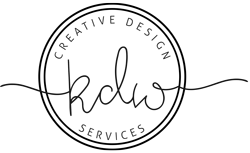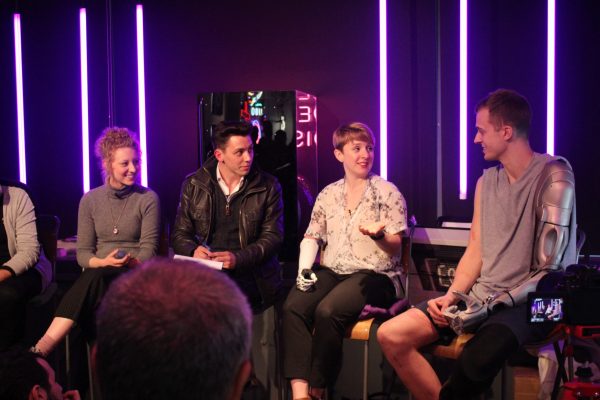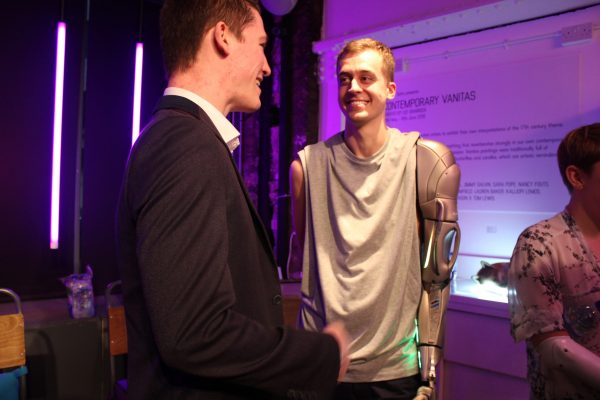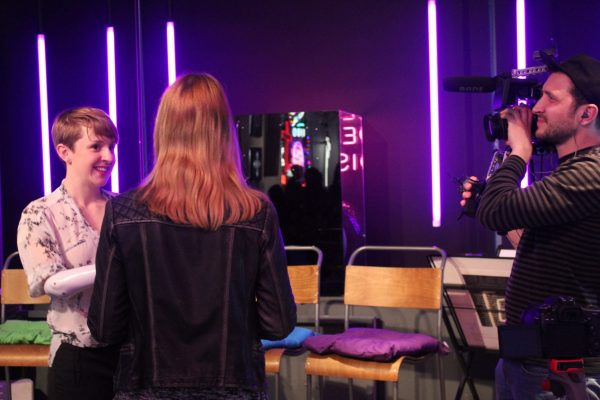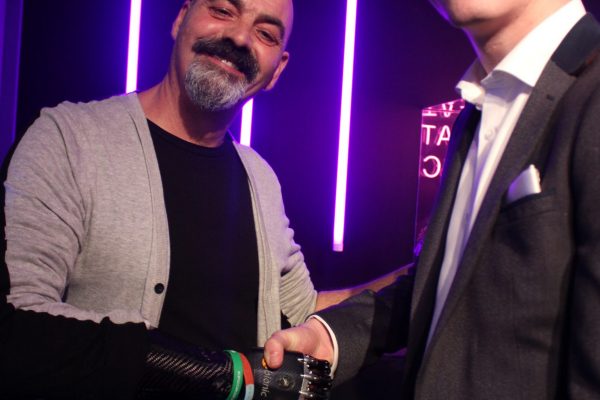Table of Contents
Video provided by Virtual Futures
e started our journey to the Virtual Futures’ Prosthetic Envy event in London through a grueling Norfolk thunderstorm, but still, we arrived at the London venue with high spirits. We were eager to hear from the guest speakers, Nigel Ackland, Nicky Ashwell, Cathrine Disney, James A.H. Young, Luke Robert Mason, and author in residence, Stephen Oram.
The event was tucked away in the heart of central London’s heaving Soho district. The Lights of Soho venue appropriately set the tone to the event with a modern neon Tokyo style ambience and décor. We were greeted by Luke Robert Mason, director of Virtual Futures and our host for the evening. He kindly introduced us to Nigel Ackland also known as the “Pioneering Pilot of the bebionic Prosthetic”, who we later had the pleasure of interviewing in the chasms hidden beneath the ever-growing eager audience gathering in the upstairs bar.
The futuristic aesthetic eased us into the notion of why an expanding audience is becoming increasingly more infatuated with the idea of replacing healthy limbs with prosthetic prosthesis. There was a wide variation of panellists highlighting different views and types of prosthetic or in some cases no prosthetic. James Young’s towered over the panel as an advocate for the Alternative Limb Project and KONAMI. Who, through an advert, was able to be fully involved in the development of his prosthesis which most people with prosthetic limbs won’t get to experience. As a confident charismatic speaker he highlighted the importance of the advancements that are needed to create a fully functional comfortable prosthesis.
The futuristic aesthetic eased us into the notion of why an
expanding audience is becoming increasingly more
infatuated with the idea of replacing healthy limbs with
prosthetic prosthesis.
Although losing two limbs due to an accident was respectfully a difficult ordeal for James and his family he has turned the public eye to a more positive outlook towards prosthetic. He also stressed the importance of the integration between technology and practicality in future prosthetic design. This opportunity to discuss his journey to those who want to gain a better understanding has taken him to different parts of the world including the Bodyhacking event in Texas and the glamorous Lights of Soho. Although initially he was hesitant in presenting the prosthesis when it was in its initial stages of development he considered whether drawing attention to a disability would be a benefit or a hindrance. His current campaign is taking the art of prosthesis to the next level, working towards grafting the prosthetic arm to his skeletal system to gain more realistic control over the animation. We even discussed the ability of integrating an on-board artificial intelligence for the prosthetic limb.
Nigel imparted some thoughtful points on prosthetics in current society. He stressed the importance of a standardised prosthetic limb being available to the public who request it, and a more realistic prosthetic re-purposing system. Where one prosthetic becomes obsolete it is then re-purposed instead of discarded. Nigel spoke about experiencing the phantom limb. This means having the sensation of moving the amputated limb through the prosthetic, this manifested itself through micro movements you could see particularly in the fingers of his prosthesis when engaging in conversation. However, those who accepted assistance from the NHS receive a counter-intuitive hook prosthesis. These have minimal mobility and often cause physical and mental stress for the user. Nigel spoke openly about misapprehensions he experienced when wearing the hook prosthetic when out in public. An often painful reality that an air of ignorance follows people with prosthetics. Some may argue this misconception is fuelled by this generation’s subconscious misinterpretation of those with prosthetics becoming villains, instilled in communities through popular children’s media and literary culture.
Nicky Ashwell and Cathrine Disney had a unique outlook on prosthetics. Instead of losing their limb through an accident later in life. They were both born without the limb and therefore adapted everyday tasks from birth, this also meant they don’t experience the concept of the phantom limb. This sparked a debate as to whether the prosthesis adds to mobility or if it hinders movement when the wearer has every capability without the prosthesis. Cathrine chose a different route where she believed that the prosthetic was counter-intuitive, finding that she can complete actions faster and more efficiently with her current capabilities. The notion of having to relearn seemingly easy tasks with a heavy, clunky and not entirely user friendly prosthetic was not something Cathrine wished to pursue. Alternatively Nicky chose to take on the challenge of learning how to effectively use her prosthesis to help her expand her capabilities and reduce the workload on her existing arm. Nicky was approached to trial a new female scale version of the bebionic arm which had a smaller more delicate ergonomic design. This leads us into developing an individuality in prosthetics giving the wearer their identity back, expressing themselves as an extension of their body rather than just a tool.
The experience and inspiration we gained by hearing from the passionate speakers was perception changing. They persuasively shared their diverse spectrum of views on a variety of different prosthetic related topics. BodAi believe that the future of prosthetics will have some kind of artificial intelligence integration and be manoeuvrable high tech that would become the norm in more economically developed global societies.
Written by co-autors: Kathrina Wainstok and Zak field.
